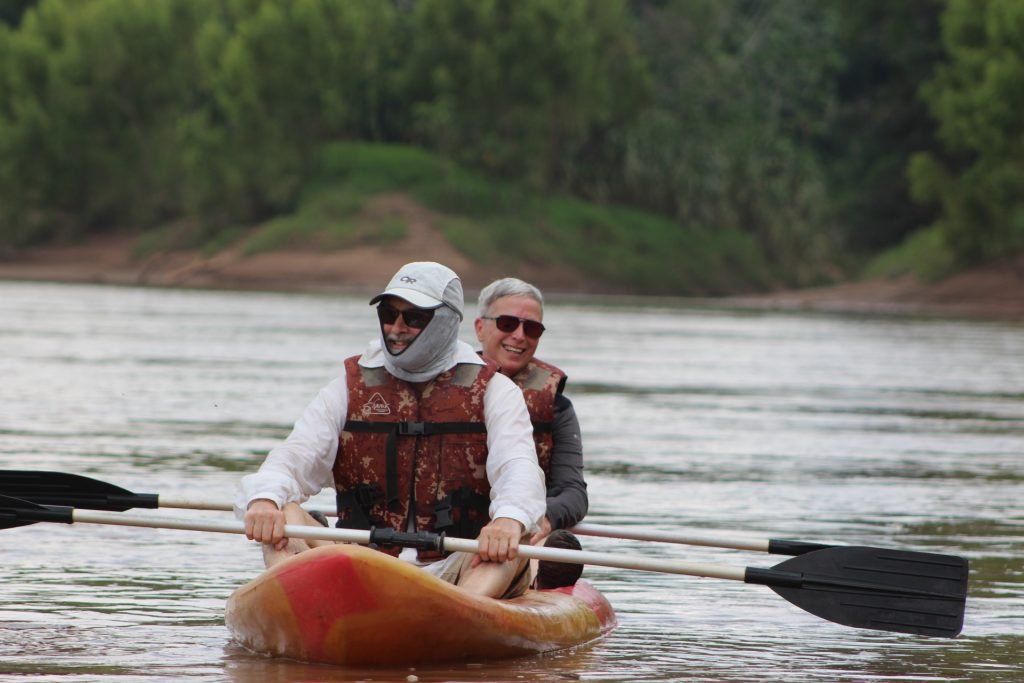The Tambopata National Reserve was created in September 2000 to protect a huge swath of lowland rainforest along the southern bank of the Tambopata River, and all the species that this particular ecosystem harbored.
The reserve overlaps the departments of Madre de Dios and Puno, covering an area of 274,690 hectares (1,061 square miles) from Puerto Maldonado to the Bolivian border to the east, and the Bahuaja-Sonene National Park to the south, within the majestic country of Peru.
The altitude you will find throughout this expanse of terrain ranges from 260 m and the highest points composed of mountainous forests reach 600 m in altitude. Although you should know that the region is dominated by the alluvial plains of its numerous meandering rivers, such as the Tambopata, the Malinowski and the Heath, which flow into the Madre de Dios River, the most important river that crosses this area.
The most striking feature of this landscape are the isolated ancient riverbeds, the lagoons called cochas, and the entire ecosystem teeming with wildlife.
Flora and fauna of Tambopata National Reserve
In this lowland region, the rainforest is technically known as Subtropical Rainforest. Simply put, this means that the climate is “hot and humid”, i.e. the temperature is pleasant but not stifling and there is high humidity in the atmosphere.
Like all Amazonian reserves in Peru, the area is known for its incredible biodiversity: more than 1,700 species of flora; more than 600 species of birds; 200 species of fish; 160 different types of reptiles and amphibians; and a staggering 1,217 varieties of butterflies.
In addition, Tambopata is known for the abundance of large jungle animals among which we can find:
- Black caiman (Melanosuchus niger)
- Giant Otter (Pteronura brasiliensis)
- Jaguar (Felis onca)
- Puma (Felis concolor)
- Ocelot (Felis pardalis)
- Jaguarundi (Herpailurus yagouaroundi)
- Tapir (Tapirus terrestris): tracks can be seen on trails and riverbanks.
- Collared peccary (Perari tajacu)
- White-lipped peccary (Tayassu perari)
- Capybara (Hydrochoerus hydrochaeris)
- Hoffmann’s two-toed sloth (Choloepus hoffmanni)
- A large number of monkey species, including
- Red howler monkey (Alouatta sara)
- Black-faced spider monkey (Ateles chanek)
- Saddle-backed tamarin (Saguinus weddelli)
- Squirrel monkey (Saimiri boliviensis)
- Toppin titi monkey (Callicebus toppini)
- Nocturnal Monkey (Aotus cf. nigriceps)
- Big-headed Capuchin (Sapajus macrocephalus)
- White-headed Capuchin (Cebus cuscinus)

The diversity of habitats offers the best birding opportunities, especially at the world-famous kolpas: clay licks that attract at least three species of blue-and-yellow, scarlet and red-and-green macaws – along with parrots and parakeets – to extract minerals from the exposed riverbank to supplement their diet and cleanse their system of toxins from their diet, the best times to observe the clay licks are during sunrise or sunset.
On a busy morning, the effect you will experience is a riot of color and noise from the birds, which is undoubtedly one of the highlights of a visit to the Amazon rainforest, a moment of great satisfaction for nature lovers.
Of the approximately 600 species of birds that can be found in the TAMBOPATA NATIONAL RESERVE, these are some of the most striking that you will find during your visit:
- Rufescent Tiger Egret (Tigrisoma lineatum)
- King vulture (Sarcoramphus papa)
- Roseate Spoonbill (Platalea ajaja)
- Sharp-billed Curassow (Mitu tuberosum)
- Horned Curassow (Pauxi unicornis)
- Variegated Tinamou (Crypturellus variegatus)
- Bittern (Eurypyga helias)
- Golden-tailed sapphire (Chrysuronia oenone): a member of the hummingbird family
- White-necked Jacobin (Florisuga mellivora): another hummingbird
- Crested eagle (Morphnus guianensis)
- Giant harpy eagle (Arpyia harpja): the most powerful bird of prey in the world.

Anthropology in the Tambopata Natural Reserve
There are small indigenous populations such as the Ese Ejja and Pukirieri communities that inhabit the protected the protected zone surrounding the Tambopata Reserve.
In 1974, members of the Ese Ejja community formed the first officially recognized native community in Madre de Dios in Infierno, with the legal concession of 9,558 hectares (37 square miles) of land on both sides of the Tambopata River.
This community owns the excellent Posada Amazonas Amazon Lodge. Profits are shared among the entire community, which also provides most of the staff and adapted to work in the area benefiting from the income that tourism provides for the area.
Many of the excursions reflect the close relationship between the lodge and the Ese Ejja, with storytelling activities, home visits and handicraft workshops, which you can enjoy if you decide to stay at this lodge, these activities will guarantee a coexistence with the community that is sure to be an experience that more than one will love.
How to visit the Tambopata Natural Reserve
The rivers provide the main travel routes into the reserve, starting and ending in Puerto Maldonado and transporting the visitor in comfortable motorboats.
Tambopata River: Starting your journey across the river from Puerto Maldonado, you will be able to see the snow-capped peaks of the Andes.
On the banks of the Tambopata there are several excellent Amazon lodges, such as Wasai and Refugio Amazonas, and one of the most remote lodges in the world, Tambopata Research Center.
For an in-depth exploration of the Tambopata River, on its way from the Andes Mountains near Lake Titicaca to the Amazon River, we have an epic rafting itinerary that traverses the Tambopata River.
Madre de Dios River: The Amazon lodges are located one to two hours away by speedboat downriver from Puerto Maldonado.
One of the most luxurious lodges in all of the Peruvian Amazon, the Reserva Amazonica lodge, is located on its banks.
Lake Sandoval, an oxbow lake created by the Madre de Dios River, is very popular and known for its family of giant river otters that you will see during your visit.





